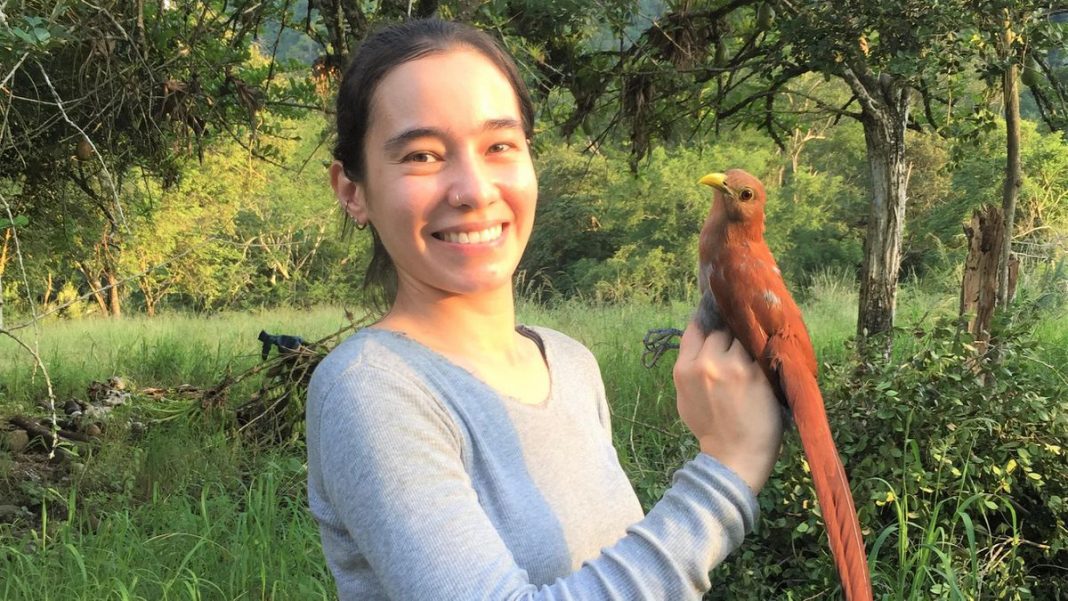Colombian scientist Daniela Garzon with a Piaya cayana, during an expedition made up of female … [+]
Daniela Garzon
The fate of Colombian ornithologist Daniela Garzon changed forever when a chance assignment at university led her to fall in love with hummingbirds — she’d then go on to follow in the 100-year-old footsteps of a female bird collecting pioneer Elizabeth Kerr.
Garzon, who is now completing her undergraduate studies in biology at the University of Tolima, grew up in the central Colombian city of Ibague, Tolima and says her eureka moment came in her third-semester of her degree, when her vertebrate biology professor assigned her to do a presentation on Trochilidae, the hummingbirds.
“I didn’t want to have that assignment, I actually tried to exchange it for the group with toucans in it,” Garzon says, adding that by the time the assignment was done, she was smitten with hummingbirds, of which Colombia more than 160 species, more than any other country.
“I fell in love with the hummingbirds because they were the first step in getting to know all the other birds and ornithology,” she says. “I also love their impressive colors and the function that they fulfill in the ecosystem.”
Garzon’s current project involves looking at the interaction between hummingbirds and flowers.
“Different flowers deposit pollen on different parts of the hummingbird’s body, for example, on the head or beak,” she says,”We then look at the pollen underneath the microscope to determine what kind of pollen it is and where it comes from, which gives scientists a lot of information about which birds interact with which plants.”
Garzon says that hummingbirds, which are found from the United States down through Latin America, are impressive birds that can even fly backwards.
“Scientists are always discovering new things about them,” she says.
The members of an all-female bird science expedition (left to right), Natalia Ocampo-Peñuela, … [+]
Natalia Ocampo-Peñuela
All-Female Expedition
In December of 2020, Garzon was invited to be part of a five woman expedition called “BIO: wings, songs and colors.” These women spent four days in the vicinity of Fresno, Tolima, eventually collecting 89 species, including some endemic species and those in danger of extinction.
The trip was part of a series of expeditions to follow in the footsteps of naturalist Frank Chapman’s Colombian Expedition of the American Museum of Natural History from 1911 to 1912.
But prior to Chapman’s arrival, Elizabeth Kerr was working alone collecting mammal and bird specimens in Colombia and was in correspondence with Chapman.
“They used the specimens she collected as a base for their own expedition,” Garzon says, adding that Kerr’s contribution was overlooked for almost a century, with most historians reviewing the documents not picking up on the fact that she was a woman.
“We didn’t have her route exactly, but with small points of reference from historical documents, we selected Fresno, Tolima, as the place we were going to search,” she says.
Garzon says that prior to her own expedition, she’d received many comments along the lines of “Are you sure you can go there, are you sure you can wield a machete?”
Garzon says that even though biological field work has been largely seen as the domain of men, the women on the expedition were able to gather valuable data “wielding our own machetes.”
“It was inspiration to work with these other female ornithologists,” Garzon says,”but also it was great to inspire confidence in women and girls in the field, particularly here in Tolima.”
A Tolima Blossomcrown hummingbird (Anthocephala berlepschi) feeding on nectar at an orange flowering … [+]
getty
Another young female Colombian with a passion for birds is Ana María Morales. She was on her way to a pro-golf career, when she chose to follow her passion for birds of prey, also known as raptors.
She is now based in Bogota and helps to document and conserve birds of prey.




